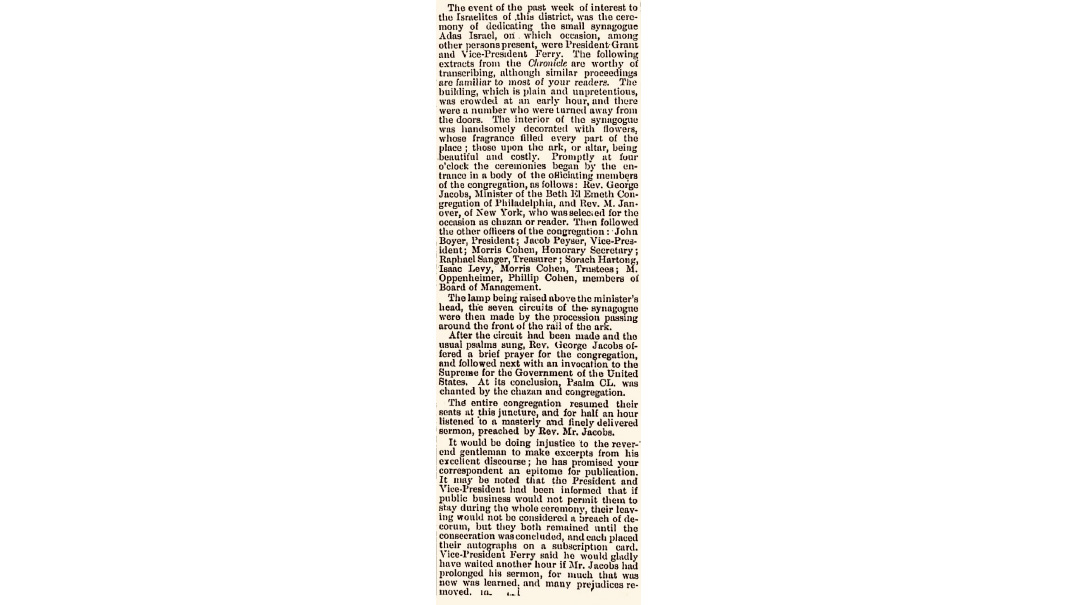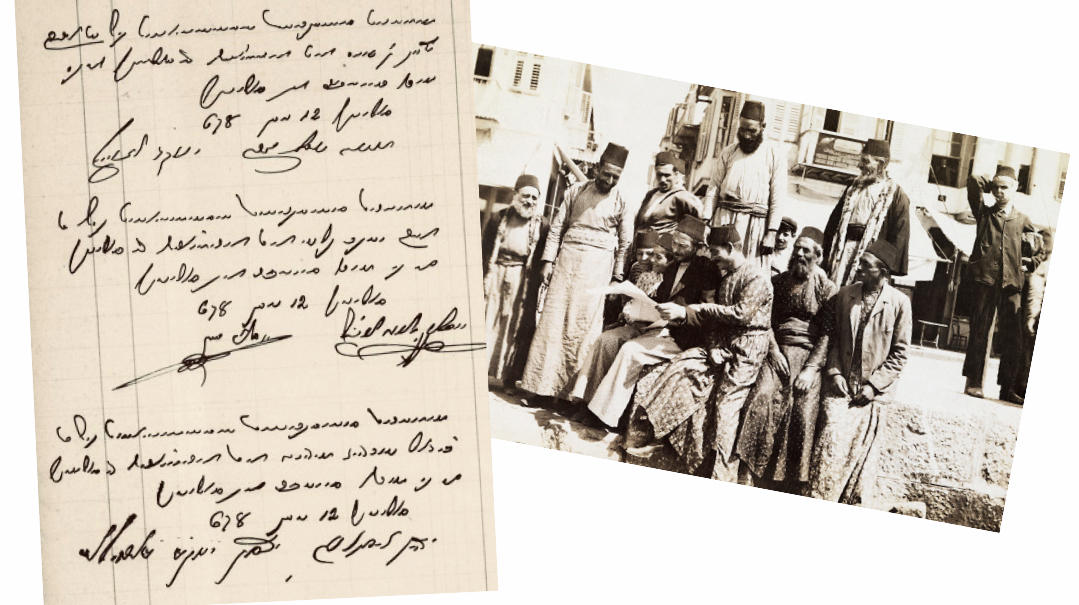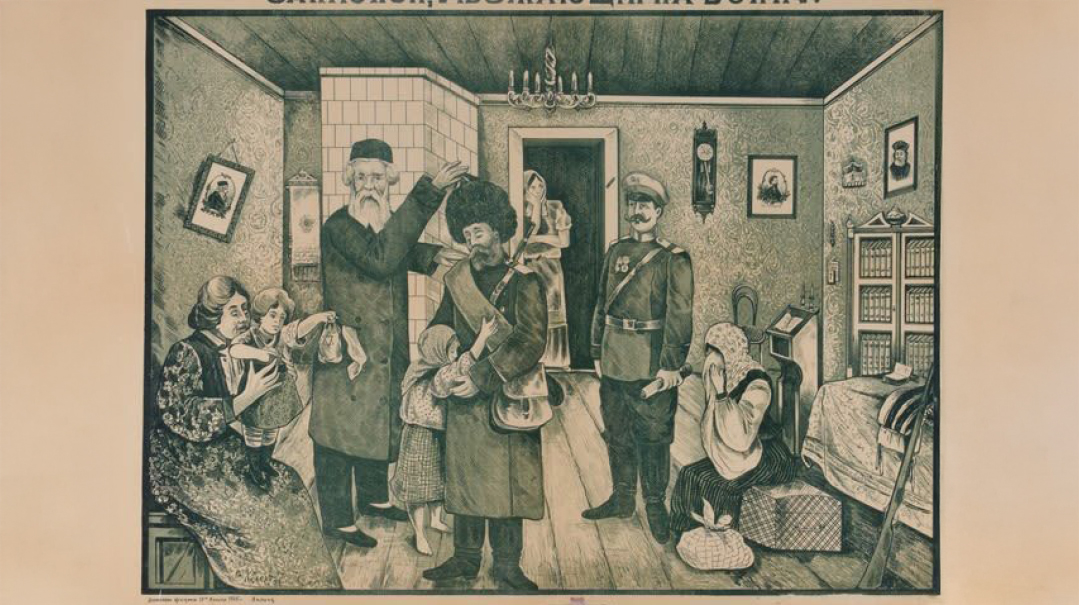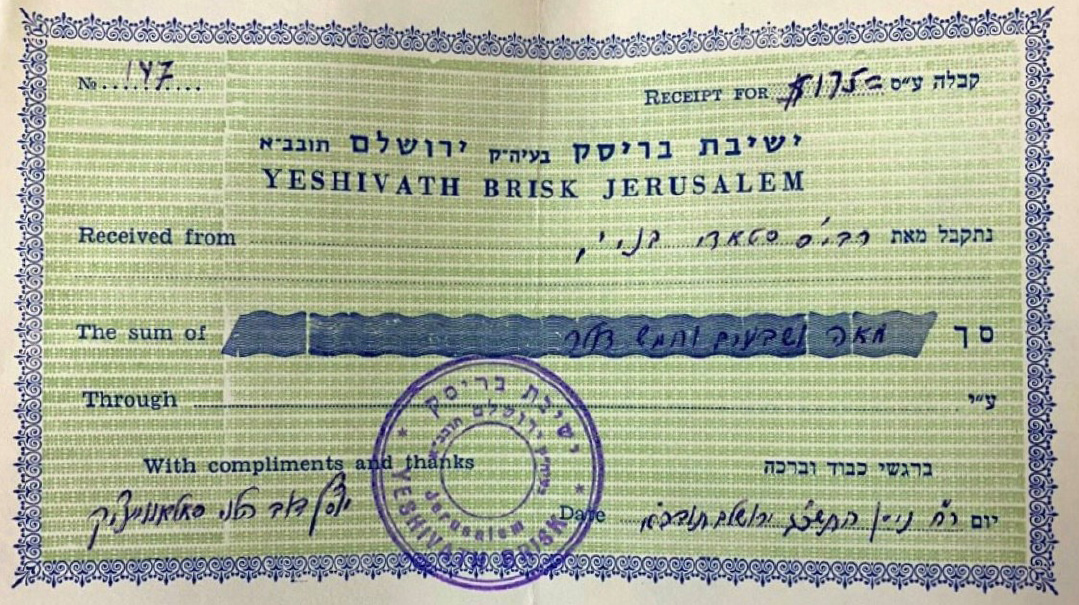When the President Came to Shul
| June 10, 2025On a sweltering Friday afternoon, June 9, 1876, an extraordinary scene played out

Title: When the President Came to Shul
Location: Washington, D.C.
Document: The American Israelite
Time: June 1876
AT exactly 4 p.m. on a sweltering Friday afternoon, June 9, 1876, an extraordinary scene played out on the corner of 6th and G Streets in the heart of Washington, D.C.
President Ulysses S. Grant — accompanied by his son Ulysses Jr. and acting vice president Senator Thomas Ferry of Michigan — took his place on one of two small sofas arranged specially for the occasion inside a modest brick synagogue. The building was festooned with evergreens, flowers, and American flags draped over the ark, while carpets lined the entrance and fresh sod covered the lawn outside.
What Grant witnessed was the dedication of Adas Israel — the city’s first Orthodox synagogue — and, according to contemporary reports, the first time in American Jewish history that both a president and vice president had attended a synagogue consecration.
The three-hour ceremony marked the culmination of a 24-year journey that began in the parlor of Herman Lissberger’s Pennsylvania Avenue home. On April 25, 1852, 21 German-Jewish immigrants gathered there to establish what they carefully termed a “Hebrew Congregation,” preserving their discussion in elegant German script — a statement of both Jewish identity and cultural heritage.
By 1869, members like Leopold Oppenheimer and Levy Cohen had grown increasingly uneasy with the Washington Hebrew Congregation’s drift toward Reform. Rather than compromise their commitment to halachah, they broke away and founded what they pointedly called the “Adas Israel Hebrew Congregation” — an open declaration of loyalty to their Orthodoxy.
Adas Israel’s early years were defined by instability and grit. Minyanim met in living rooms. For a time, it was housed in a building directly opposite Ford’s Theatre — likely davening there on the fateful night President Lincoln was assassinated. They then moved to 4th Street, then 9th, then to the memorably named “Finkman’s Hall near the Engine House.” They were grateful for what they had, but their future felt far from guaranteed.
The congregation’s constitution, adopted during these tumultuous years, reflected the strictures of German-Jewish immigrant congregations. Membership was denied to the intermarried, and an elaborate system of fines governed behavior — a dollar for smoking during services, 50 cents for failing to attend when called for a Torah reading, 25 cents for “noisy disturbances.”
The president of the shul, who was required to “abstain from all secular pursuits on the Sabbath,” wielded almost autocratic power and was empowered to “impose fines of not less than 50¢ nor more than $5.00 on members guilty of improper conduct.” Children under five were banned entirely, and an elaborate judicial system addressed “officers and members who may be guilty of misdemeanor,” with trials requiring signatures from four members and punishments ranging from suspension to expulsion.
Despite these strict regulations, the congregation struggled with the same challenges that plague shuls to this day. Board minutes reveal repeated, unsuccessful attempts to control the “hilarity associated with the Purim service.” Another issue that came up repeatedly each Yom Tov during the shul’s early years was Bircas Kohanim — during which “each Kohein chanted at his own pace and worse, in his own key” — prompted Selig Goldstein to suggest nominating a single Kohein to lead while others echoed responses. The experiment failed when the other Kohanim objected to the innovation.
The building campaign, which took several years, received a boost from a substantial donation by Jacob Schiff as well as from several other wealthy Jews across the country, who ranged from German-born to Sephardic.
The 1876 dedication was staged with exacting care to showcase both Jewish pride and American patriotism. The building was decorated with $15 worth of evergreens and flowers. Admission required printed tickets. The date was timed to coincide with the country’s centennial celebrations. Seven sifrei Torah were assembled — one belonging to Adas Israel, six borrowed from neighboring communities — and the local press marveled at “the impressive procession that circled the sanctuary seven times before reaching the ark.”
Rev. George Jacobs, who was the legendary American Orthodox pioneer Isaac Leeser’s Jamaican-born successor, delivered the dedication sermon. The liturgy was led by Rev. Jannover, chazzan of New York’s Henry Street Synagogue. Though Leeser had passed away in 1868, his influence endured. Many of Adas Israel’s founders were inspired by his vision, and now looked to his spiritual heir.
Jacobs, a Sephardic Jew born in Kingston, Jamaica, had arrived in the United States in 1854, first settling in Richmond before being called to Philadelphia in 1869 — the same year Adas Israel officially seceded from Washington Hebrew. Like his mentor, he was a founding member of the Jewish Publication Society and contributed to the Szold-Jastrow siddur. The three-hour service drew an overflow crowd. Latecomers were turned away.
Contemporaneous accounts note that President Grant and the attending dignitaries contributed when donation cards were passed out at the close. President Grant would be the first among scores of dignitaries — both American and Israeli, politicians and heads of state — who would identify Adas Israel as the central Jewish synagogue of the nation’s capital.
The President and the Jews
Grant’s presence was loaded with symbolism. Fourteen years earlier, in December 1862, as a Union general, he had issued the infamous General Order No. 11 — expelling “Jews as a class” from his military district, accusing them of illegal cotton trade. The decree provoked national outrage and was swiftly rescinded by President Lincoln. But the stain lingered.
His attendance at Adas Israel was widely seen as an olive branch to the Jewish community. Grant, known for his fondness of formal pageantry, seemed moved by the Torah procession and Hebrew liturgy. In the context of the centennial, his gesture resonated deeply: a former general seeking forgiveness, a nation seeking unity, and a people finally welcomed into the American story.
The Traveling Synagogue
The building that once hosted a president and a Torah procession proved no less mobile than its founders. In the 1960s, construction of the Metro headquarters threatened it with demolition. But the Jewish Historical Society of Greater Washington intervened. In 1969, President Nixon signed legislation allowing the District to purchase the building and lease it to the Society for $1 per year, for 99 years. The building was transported three blocks over, to Third and G. Then again in 2016. And once more in 2019. Today, it stands proudly as part of the Capital Jewish Museum complex — the oldest synagogue structure in Washington, D.C., and among the oldest in the United States.
A brick-and-mortar witness to Jewish persistence. And now heartbreakingly, a silent witness to tragedy. Last month, two Israeli embassy staff were killed in cold blood just steps away — while attending an event at the adjacent Capital Jewish Museum. The silent walls of the historic structure mix past and future, tragedy and rebuilding, and continually symbolize the eternity of the Jewish People.
(Originally featured in Mishpacha, Issue 1065)
Oops! We could not locate your form.






